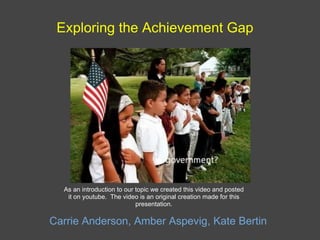
Achievment gap slides
- 1. Exploring the Achievement Gap Carrie Anderson, Amber Aspevig, Kate Bertin As an introduction to our topic we created this video and posted it on youtube. The video is an original creation made for this presentation.
- 2. What is going on? http://lascobrasvenenosas.blogspot.com/2009/05/la-confusion-por-begona.html
- 6. There is no simple answer.
- 13. This short clip provides a first look, from California- (youtube, "Who is accountable?", Langerston & Lee)
- 20. Mathematics: Figure 13-1: Average mathematics scale scores of 4th- and 8th-grade students, by school poverty level: Selected years, 2000-09 NOTE: The National Assessment of Educational Progress (NAEP) mathematics scores range from 0 to 500 for grades 4 and 8. The percentage of students eligible for free or reduced-price lunch ranges between 0–25 percent in low-poverty schools and between 76–100 percent in high-poverty schools. For more information on NAEP, see supplemental note 4 and for more information on free or reduced-price lunch, see supplemental note 1 . SOURCE: U.S. Department of Education, National Center for Education Statistics, National Assessment of Educational Progress (NAEP), selected years, 2000–2009 Mathematics Assessments, NAEP Data Explorer.
- 21. Figure 13-2: Average mathematics scale scores of 12th-grade students, by race/ethnicity: 2005 and 2009 NOTE: The framework for the 12th-grade mathematics assessment was revised in 2005; as a result, the 2005 and 2009 results cannot be compared with those from previous years. At grade 12, mathematics scores on the revised assessment range from 0 to 300. For more information on the National Assessment of Educational Progress (NAEP), see supplemental note 4 . Race categories exclude persons of Hispanic ethnicity. For more information on race/ethnicity, see supplemental note 1 . SOURCE: U.S. Department of Education, National Center for Education Statistics, National Assessment of Educational Progress (NAEP), selected years, 2005 and 2009 Mathematics Assessments, NAEP Data Explorer.
- 22. Reading: Figure 11-1: Average reading scale scores of 12th-grade students, by race/ethnicity: Selected years, 1992-2009 NOTE: The National Assessment of Educational Progress (NAEP) reading scale ranges from 0 to 500. Testing accommodations (e.g., extended time, small group testing) for children with disabilities and English language learners were not permitted in 1992 and 1994; students were tested with and without accommodations in 1998. For more information on NAEP, see supplemental note 4 . Race categories exclude persons of Hispanic ethnicity. For more information on race/ethnicity, see supplemental note 1 . SOURCE: U.S. Department of Education, National Center for Education Statistics, National Assessment of Educational Progress (NAEP), selected years, 1992–2009 Reading Assessments, NAEP Data Explorer.
- 35. Institutional: Racism The Stereotype Threat http://news.columbia.edu/files_columbianews/imce_shared/steele300.png Claude M. Steele talks on NPR about how stereotypes can negatively impact academic performance... http://www.npr.org/templates/story/story.php?storyId=128082797
- 36. Tim Wise speaks further as to the negative impact of racism on education...
- 39. Sociocultural : Poverty and school-readiness PBS segment on low-income children's school readiness in Chicago- http://video.pbs.org/video/1869856777/ (click to view) “ Nearly 90% of the variance in students' math scores on some tests can be predicted without knowing anything about their schools; one only needs to know the number of parents in the home, the level of the parents' education, the type of community in which the family lives, and the state's poverty rate” (D. Brandon and G. Robinson (1994),cited in Evans, 2005, p. 584) http://coto2.files.wordpress.com/2010/04/child20poverty.jpg
- 42. Like most pieces of this puzzle, the answer is complicated. Poor students often don’t have access to good nutrition, either in utero or as children. Poor nutrition can lead to developmental limitations both at birth and as the child is growing. The student who lives in poverty may not have as many cultural enrichment opportunities (such as attending concerts or museums), may not experience as much parental support for education (due to the parents’ own educational limitations or bad experiences with education), and may live in areas with poorly funded schools and equally poor teachers. (Orlich & Gifford, 2006). Many minority schools have an incredibly high teacher turnover rate, with first-year or inexperienced teachers cycling in and out of the system (Ingersoll, 2001). WHY? http://www.magazine13.com/img/lifestyle/smiles-in-poverty/smiles-in-poverty20.jpg “ We can accurately project a child's chances of completing college and her eventual income by knowing only her ZIP code.” (H. Gardner, cited in Evans, 2005, p. 584).